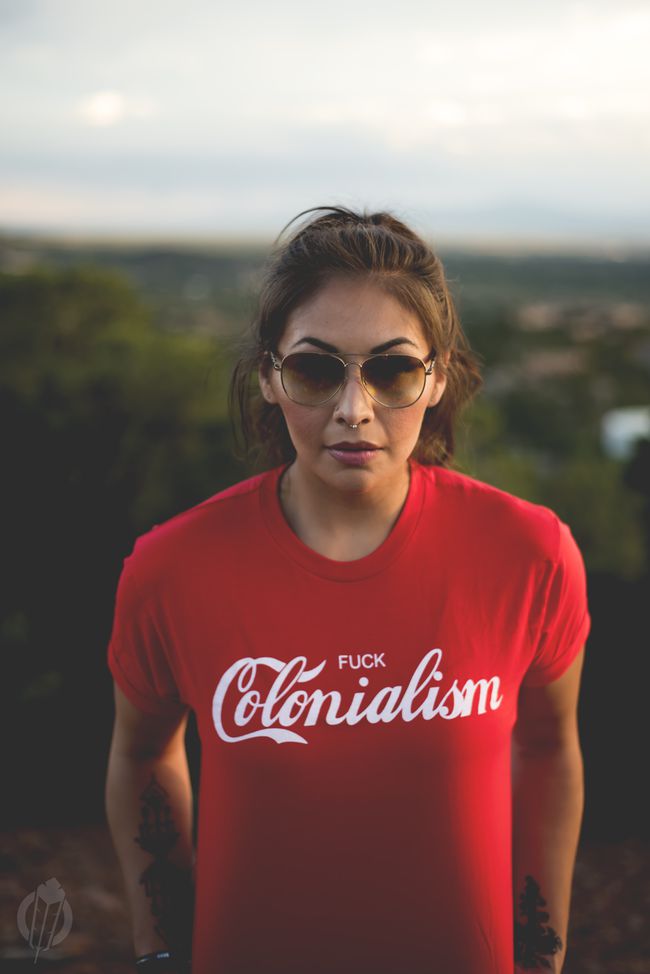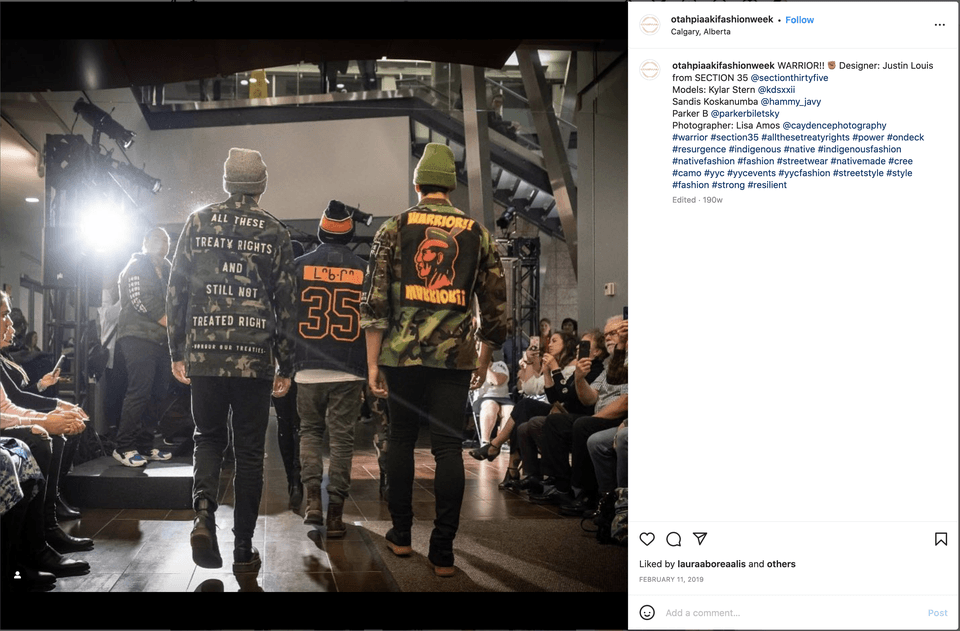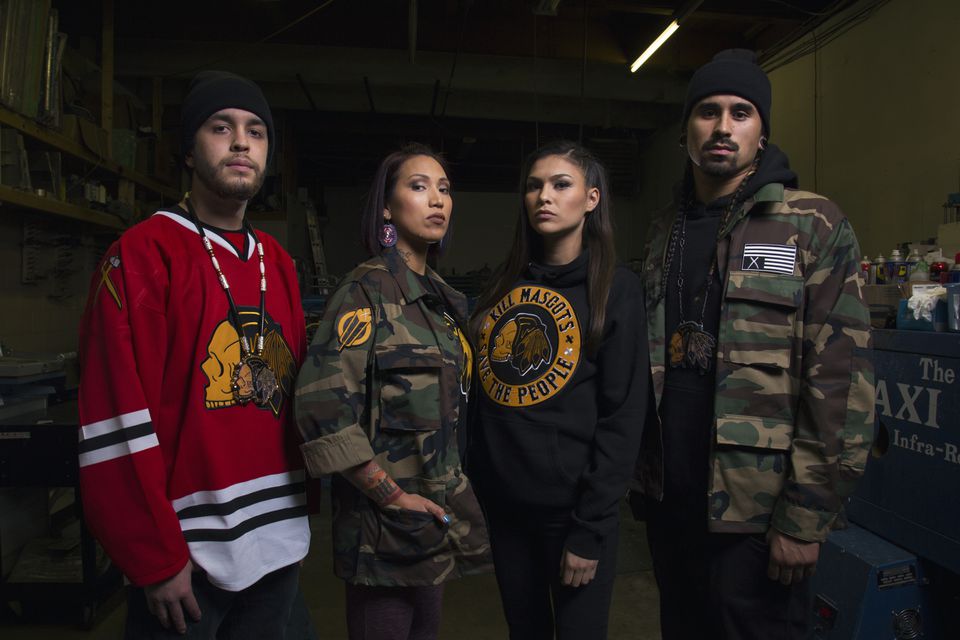Front-line Fashion
Justin Louis speaks with Irene Chin about how fashion tells Indigenous stories and takes up space
- IC
- It gets complicated when a commodity comes into conversation with activism. How do you position yourself between commerce and culture?
- JL
- Culture is a big part of who we are [as Indigenous streetwear designers]; our mission is to represent Indigenous culture authentically. We want our people to have something that they can connect to and wear that represents who they are. This is a big part of who we are and what we do as a brand, but there are many different challenges that arise when commodity comes into contact with front-line movements. People are making money by exploiting trends. We‘ve been involved in numerous fundraisers, but if something is really based around some type of movement, we always donate all the money. I don’t believe in benefiting from movements that are based on resistance to the oppression of people.
- IC
- How do you use imagery and icons—like the Coca-Cola logos, etc.—as a specific communication technique? How do you subvert their meaning?
- JL
- In streetwear, people like to flip logos—and we do it too. There was of course an irony to the “Fuck Colonialism” t-shirt—a message that we share and carry. Our people have had so much taken from us that we say, Why can’t we take logos from other people and flip them and share a message that’s important to our people, and that our people relate to? It’s not the most technical design work, but it’s prominent and people connect to that stuff. There’s usually a humorous side too—Indigenous people like to laugh a lot. There’s always some sarcasm and humour in icons.
For the other one we did, the “Kill Mascots” shirt, we collaborated with an artist in Chicago named SANTIAGO, who came up with the concept. There was a big movement at the time around mascots and native mascots and the dehumanization of Indigenous people. So, we created a big collection around the Chicago Blackhawks; we took the logo and played with it. The message resonated with our communities and it’s one of our most popular releases to date. Where I come from, ice hockey is big, and everybody recognized the Blackhawks colours—and right away, they loved it. But the most important piece was the message. But we actually got a cease and desist letter from the National Hockey League for one of our previous “Fuck Colonialism” logos. As we’ve grown as a brand, we’re much more careful about the imagery we use; you have to be mindful of copyright laws…
- IC
- Could you talk a little bit about your display at the Met? Or other examples?
- JL
- The main piece is a leather letterman jacket that we made. Quite a lot of thought went into the design and it’s very subtle—it’s tonal—with Cree syllabics on the sleeve that translate to “The good life”—miyo-pimâtisiwin. And there is a horse that is a representation of my family and my culture. Horses are very important where I come from. Language is also extremely important and it’s something that we’re trying to preserve and continue to bring back.
It’s probably one of my favourite pieces I’ve ever designed, so when the Met reached out and identified it as something they wanted to have…I was over the moon. It’s a very meaningful piece to me, as a Cree man. The values that I carry bleed into that piece, and it’s really cool to see it in the Met, sitting right next to Jerry Lorenzo’s work. - IC
- We have Balenciaga staging a show at the New York Stock Exchange as a critique of capitalism to some degree or Vetements doing a show at a McDonald’s—fashion is inseparable from corporate consumption. How does retail work against institutions like the stock exchange or the museum?
- JL
- Retail can become a resource for working against some of these capitalistic structures. Retail has become a tool to raise resources and direct them to people who need them, like those who are fighting for their lands and their waters against the big multinational companies that are coming through their territories.
- IC
- Section 35 was part of an Indigenous fashion collective, and in 2019 you partnered with The Hundreds on a capsule collection that called attention to and raised funds for pipeline protests. Its graphics and tactical designs were very powerful, but can you talk a bit about the location of that fashion show?
- JL
- The long story is that in the previous year, the city of Los Angeles had voted to abolish Columbus Day, changing it to Indigenous Peoples’ Day. They had then decided to hold a celebration at City Hall to celebrate Indigenous Peoples day, and they shut down the city block around there for this celebration of Indigenous artists and cultures and did their best to honour the Indigenous peoples of Los Angeles. Part of this event included a stage for artists to perform.
And through this, we were lucky enough to get an invite to come and take up space at this event. It was really a celebration of people coming together to reclaim the space. In L.A., the original peoples of that land are all but forgotten. So for a group of Indigenous designers to be able to come and do a fashion show there was really cool, there was also a lot of meaning to it. The whole theme behind the collaboration was driven by some of the artists and the collective who are front-line people and have spent time battling multinational corporations. A lot of the iconography was heavily inspired by front-line work. You can see the bulletproof vests, the gas masks…I thought it was bold for us to walk that type of stuff down the front of Los Angeles City Hall. It shared the realities of our communities and the stuff that our people face. - IC
- The fact that it was a public demonstration under the guise of a runway show is an amazing example of taking up space. In our Retail Apocalypse project, it’s important to understand how retail can remain spatial given that so much of it is about public interaction and seeing others consume. With globalization and gentrification, the nuances of pedestrian life are being replaced by the same kind of global brands that we recognize everywhere, and the public aspect of the shop window as a threshold and a way to communicate is fading with e-commerce; we’re becoming more and more isolated at home, just shopping online. In the postmodern era, architects used the façade of the building to play with the scale of commercial communication. And then there’s the billboard, which caters to an auto-centric culture, where everything is about what you see from the car. So, I come back to The Hundreds and this billboard from the Indigenous Peoples’ Day collaboration. Billboards are ubiquitous in our landscape. They reflect car culture and consumer culture. How do you use it to identify spaces to reclaim?
- JL
- Retail has changed a lot since I was a kid. From the time I was in university, I’ve worked in retail. You always hear that retail’s dying, that fewer brands can afford to have a brick-and-mortar space. A lot of retail is controlled by big-block retail or luxury brands that can afford those flagship stores. Retail is hard for smaller brands to have a footprint in other areas apart from maybe some wholesale opportunities. Although, I think some of the coolest spaces are small independent retail.
But a lot of people are focusing more resources on e-commerce, as the benefits of e-commerce definitely outweigh some retail benefits, but you have to balance them both to be able to survive. I don’t know where retail is going to be in ten years. Only so many brands or companies can afford to invest, to develop that type of space. You certainly see more generic big-block stuff than creative spaces.
- IC
- Could you expand on how the digital space allows you to tell your stories versus what you imagined you would do if you had access to a conventional brick-and-mortar storefront?
- JL
- We’re so interconnected digitally. Social media, all the different platforms out there—you can reach many people through the digital side of your activity. One retail space in one small part of a city doesn’t go very far. It’s crazy to see how much social media has impacted retail. You open up your app and the majority of the stuff you see is focused on the product.
- IC
- In the exhibition, we have a section dedicated to the Hudson’s Bay Company and the fur trade in Canada. The infrastructure of the company was set up for “efficiency” and what might have been framed as progress from the Western, colonial perspective. But when we look closely, it’s militaristic, it’s forts. So I’m curious about how we can think about retail as a narrative platform to talk about histories and current struggles and imagine different futures. How can we think about retail at a different scale outside of capitalist time?
- JL
- It’s hard to separate retail from capitalism. But I think there’s a lot that can be done with retail space so that it’s not just focused on its capitalist concerns…resources are also an issue for a pop-up. But for Indigenous people, when we want to take up space, we want to create something that represents who we are.
We have so many stories and there’s so much to our culture, but there are also the struggles we’ve been through. So, there’s an educational aspect to be shared, some underlying messaging that’s attached to the space we occupy. It’s not just product-focused. If we look at the future of retail in that way, I think that it would be a lot more meaningful than just focusing on the product.
Retail Apocalypse is curated by Fred Fischli and Niels Olsen. We have also published talks with architects Tadeáš Říha and Kateřina Frejlachová. The exhibition is currently on view in the Hall Cases and Octagonal gallery and runs until 15 January 2023.


